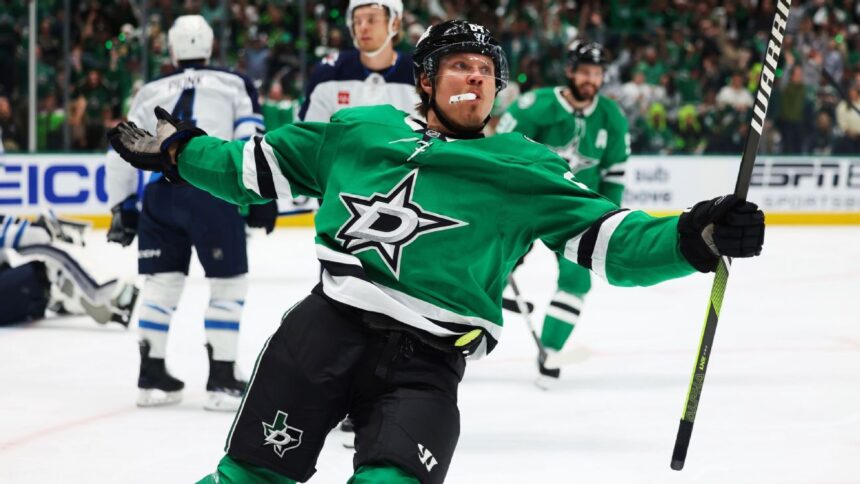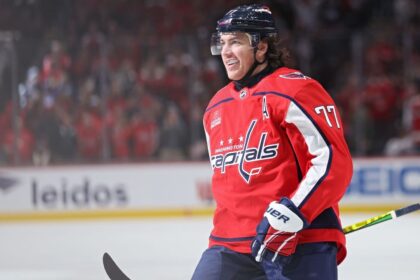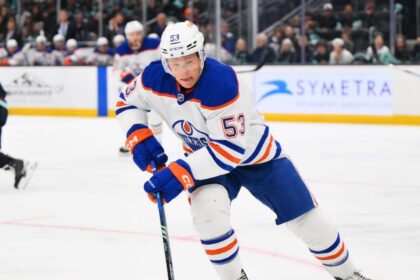The 2025 NHL Free Agency: Analysis and Ratings
The 2025 NHL offseason has already been a rollercoaster, with the trade of key players, the arrival of 224 prospects to new teams through the draft, and a series of re-signings. As free agent deals continue, we analyze the most outstanding moves, evaluating the adaptation of players to their new teams and the terms of the contracts. Here are the ratings of the most recent signings, with the newest ratings listed first.Draft Summary:
July 1st
Mikael Granlund, F
Anaheim Ducks
Terms: Three years, $7 million AAVRating: C+
Where does it fit?
Granlund is a veteran scorer who has produced on every team he has played for. Last season he had an outstanding contract year between the San Jose Sharks and the Dallas Stars, with 22 goals and 44 assists in 83 games. Granlund can play in all three forward positions. The Ducks may place him on the right wing in their top six, given that they already have Cutter Gauthier and Chris Kreider on the left side. If they want him at center, perhaps it will be behind Leo Carlsson and Mason McTavish on their third line. His offense could be used anywhere in their lineup. He is one of the best playmakers available this offseason.Does it make sense?
Granlund had 21 million reasons to leave the Stars, a perennial contender in the West, and the opportunity to play with Mikko Rantanen and Roope Hintz for a Ducks team that is probably still a year away from real contention. The Ducks have a huge amount of space in the salary cap for next season and a lot of flexibility for the second year of his contract. They had the ability to overpay for a forward. The fact that they chose to do it with Granlund is what’s complicated. For a team trying to improve its overall defense, Granlund is anything but a 200-foot player. He was negative relative to his teammates in all defensive aspects in Dallas, from shot attempts to scoring chances against. I’m not sure that’s the case for Granlund and I’m not sure, given the Ducks’ terrible 5-on-5 defense last season, that he’s a free agent that Anaheim necessarily needed to add.Corey Perry, RW
Los Angeles Kings
Terms: 1 year, $2.5 million AAVRating: B+
Where does it fit?
Corey Perry has been at this for nearly two decades. And the 40-year-old player still has it (to some extent). He will be a bottom-six scoring winger for the Kings, a presence in front of the net, and a constant agitator. Perry scored 19 goals and 30 points in 81 games for Edmonton last season in a primarily fourth-line role and has remained consistent in his production as he continues to slow down Father Time. It was the playoffs where Perry began to ascend a bit as well, accumulating 10 goals in 22 games. He even joined Connor McDavid’s wing when Zach Hyman was forced to leave the postseason due to an injury. It’s no small feat to keep up with McDavid, and Perry didn’t seem out of place. Expect Kings coach Jim Hiller to find a spot for Perry in LA’s bottom six, where he can bring some energy along with offensive potential.Does it make sense?
If you had told the Kings 10 years ago that Perry, who constantly bothered them as a member of the Anaheim Ducks, would someday be playing alongside Anze Kopitar and Drew Doughty, it would have seemed like a fever dream. But time and wounds and all that. At this stage of his career, Perry should fit in perfectly with the Kings. He won’t have any great pressure to perform, but he is capable of doing so. He will make the Kings a more difficult team to play against, specifically in the postseason, and that’s where LA is determined to be this year (for more than just one round as well).
Joking aside about how Perry seems to end up on teams that advance to the Stanley Cup Final before losing, the guy seems to be in the right places at the right time to at least have a chance to win a championship. Of course, it’s not as if Perry is going to propel LA to become a postseason giant on his own. He’s just one part of the larger equation now. Clubs that end up making long runs each season know the value of scoring depth and leadership and experience in the spring. Perry brings all those qualities to LA.
The contract is also good for LA. Perry will cost them a maximum of $3.5 million (if he reaches all the bonuses in his one-year contract, which is unlikely), and if he ends up being the differentiating factor they need, it’s all profit. What’s past is past. This is a great moment for Perry and the Kings to team up.Nate Schmidt, D
Utah Mammoth
Terms: 3 years, $3.5 million AAVRating: B+
Where does it fit?
Call it the Florida Effect. Going to the Panthers revitalized Nate Schmidt. He had a solid regular season and was even better during Florida’s run for the Stanley Cup, producing three goals and 12 points in 23 games. Schmidt earned his minutes on the Panthers’ third pairing as an excellent rush defender, who made good decisions with the puck and had some impressive playmaking performances. Basically, Schmidt can do it all (in the right place). And he earned the raise Utah offered. The Mammoth are getting Schmidt at his (recent) best, after all. He can plug into their third pairing, carry a decent workload, and contribute at 5-on-5 and on special teams. He will also be a veteran presence on a young team that is still finding its way and creating an identity. While Schmidt isn’t the fastest skater, he is smart, confident, and experienced. A true trifecta.Does it make sense?
Absolutely.The Mammoth were a mid-season defensive team last season, averaging 3.01 goals against and lacking a true punch on their defense beyond Mikhail Sergachev and his 53-point campaign. Schmidt will help elevate the entire group. He will be an upgrade over Ian Cole and can provide a greater offensive edge than Juuso Valimaki. All good things for the Mammoth. If Utah can protect Schmidt in the right role, he should bring a Cup-winning pedigree and consistent production that improves the blue line.
Ryan Lindgren, D
Seattle Kraken
Terms: 4 years, $4.5 million AAVRating: B
Where does it fit?
Lindgren appears to be part of a broader plan that focuses on how the Kraken can improve the defensive inconsistencies that were a chronic problem during the 2024-25 season. Natural Stat Trick metrics show they were in the top 10 in terms of the most scoring chances allowed per 60, the most shots allowed per 60, and the most high-danger scoring chances allowed per 60. The Kraken were also 21st in penalty killing with a 77.2% success rate. Last season he finished with four goals and a career-high 22 points in 72 games between the New York Rangers and the Colorado Avalanche. So while there is an offensive element to his game, the intention of the Kraken or anyone who had interest in Lindgren was what he could do on the defensive end. It starts with the fact that it adds to the configuration of the first six of the Kraken, who already had Vince Dunn, Ryker Evans, Adam Larsson, Brandon Montour and Jamie Oleksiak with the idea that Josh Mahura becomes their seventh defenseman. Getting Lindgren now provides a little more flexibility, as he could be a top-four defenseman or number 5 for the Kraken, who could also be used to play an important role in penalty killing, given that he has recorded more than 127 minutes of disadvantage in each of his six complete NHL campaigns.Does it make sense?
Lindgren gives the Kraken another dimension they didn’t have before and, along with the two-way center Frederick Gaudreau, further establishes what the Kraken’s new general manager, Jason Botterill, is trying to do when it comes to the team having more defensive consistency. Although there’s a role for him with the Kraken, there’s a discussion about where he exactly fits in the defensive dynamic. Dunn and Larson have largely operated as their primary pairing, considering they provide the balance of a puck mover paired with a physical and stay-at-home option who also has a left-handed shot playing alongside a right-handed shot. If that combination remains, then it presents the second Kraken pairing as the next potential option. Montour gives the second pairing another puck mover who is a right-handed shot. It creates an opening for another defenseman who stays home with a left-handed shot. But, is it Lindgren or is it Oleksiak? And regardless of who gets the nomination, is it the most prudent decision to pay a number 5 defenseman right at or a little over $4.5 million annually? Especially when there are other financial considerations to make. They will need to come to an agreement with Evans, a pending RFA, while figuring out what the next contracts might look like for RFAs like Kaapo Kakko and Tye Kartye. PuckPedia projects they will have $13,557 in remaining salary cap space with the reality that the Kraken will need to use that money to sign their RFA class with the idea that creating more space could prompt them to make a trade.Vladislav Gavrikov, D
New York Rangers
Terms: 7 years, $7 million AAVRating: B+
Where does it fit?
This was an early birthday present for Adam Fox. The Rangers’ best defenseman saw a drop in production last season (61 points in 74 games) due to injuries and a bad year for the team overall, but also because Fox couldn’t find the right fit in his first pairing. He didn’t generate enough offense alongside his long-time partner Ryan Lindgren, who was traded to Colorado. His partnership with K’Andre Miller was more successful, but the Rangers didn’t want to commit long-term to him and traded the restricted free agent to Carolina on Tuesday. Enter Vladislav Gavrikov, a true top-tier shutdown defenseman. It gives them a left-right combination with Fox. It gives Fox what he used to have with Lindgren, which is a stay-at-home defenseman who will allow him to take more offensive risks. Gavrikov was really solid for the Los Angeles Kings last season, playing his career-average minutes (23:05) in his six-year career and facing tough competition every night. His pairing with Mikey Anderson yielded only 1.61 goals per 60 minutes at 5-on-5. He’s not the most physical defenseman, but he’s an underrated skater and plays intelligently in his own zone. Gavrikov was 12th on the Kings in penalty minutes per game (0:20) in 82 games.Does it make sense?
Fills a vital need for the Rangers, both to help Fox and to add veteran defensive depth on a rebuilding blue line. The 29-year-old is coming off a great season with the Kings and is in his prime. For all his defensive acumen, he also contributed 30 points last season. Gavrikov has some history with two current Rangers, having played with Artemi Panarin in Columbus and Igor Shesterkin in the KHL. The contract is $1.5 million annually less than that of Ivan Provorov, who just re-signed with Columbus. The gap between the two is narrow in terms of impact. It’s loaded with $25.2 million in bonuses in the first five years, but the Rangers, hopefully, won’t have to do any buyout calculations here. It’s a solid addition.Brock Boeser, RW
Vancouver Canucks
Terms: 7 years, $7.25 million AAVRating: B
Where does it fit?
The Canucks had many problems last season: underperformance, injuries, a locker room dispute that required the trade of J.T. Miller, but one of their main concerns was an offense that generated only 2.84 goals per game. Boeser had 40 goals in 2023-24 and had 25 last season in 75 games. He’s not the fastest type. He won’t dazzle you with highlight-reel moves. There are players who are better in transition with the puck. He’s simply going to convert his opportunities and help create them in the offensive zone, especially with offense coming from high-danger areas. He played around Vancouver’s lineup last season, even with the much-maligned center Elias Pettersson. If Petey is going to get his game back on track, he needs a player like Boeser. If Filip Chytil is going to be an offensive force for Vancouver, he needs a player like Boeser. That’s why it’s strange that the Canucks apparently didn’t want Boeser before signing him on Tuesday.Does it make sense?
The situation between the Canucks and Boeser was really strange. There was a considerable gap between the two parties in their contract negotiation, to the point that the team tried to trade Boeser at the deadline. Vancouver had a price in mind. Nobody came close to meeting it. “If I told you what they offered me for Boeser, you wouldn’t believe it,” said general manager Patrick Allvin. As the season drew to a close, Boeser was convinced he was playing his last games for the Canucks. “Honestly, it’s unlikely at this point,” he told Sportsnet. “It sucks, it’s unfortunate. I’m just trying to play good hockey, and then I’ll worry about everything after that.” Many assumed the Wild would sign the Minnesota native, but after hesitating on the deadline, they opted to acquire Vladimir Tarasenko. Teams like the Edmonton Oilers and the Winnipeg Jets seemed ready to pounce on Boeser. But in the end, he made an unexpected return to the Canucks for 7 years and an average annual value of $7.25 million. His agent Ben Hankinson said, cheekily: “Really, did you expect him to sign elsewhere?” Once again, everything is strange. Why not resolve this before July 1st so Boeser could have signed an eight-year contract to stay in Vancouver and reduce the impact of the salary cap? Why allow him to go to market? In the end, the adjustment makes sense for the Canucks. He has left behind injury concerns. He is a consistent scorer for a team that needs it. And while the behind-the-scenes cultural issues in Vancouver are well documented, Boeser is one of the good ones.Jake Allen, G
New Jersey Devils
Terms: 5 years, $1.8 million AAVRating: B+
Where does it fit?
Back in tandem with Jacob Markstrom. The Devils addressed their persistent goaltending issues in a dramatic way in 2024, first acquiring Allen from the Montreal Canadiens and then making a trade for Markstrom. The good news is that it worked: New Jersey’s team save percentage went from 30th in the NHL (.886) to 11th in the league last season (.898). Naturally, it was their previously reliable offense that became unreliable (20th, 2.93 goals per game) and combined with significant injuries to derail their season. The unexpected part of this goaltending solution? That Allen had better numbers than Markstrom in the regular season with a .908 save percentage and 18.4 goals saved above expected, which was ninth in the NHL. Markstrom proved his worth in the postseason with a .911 save percentage in the Devils’ five-game loss to Carolina, but Allen did his part to get them there. So New Jersey repeats it with its veteran duo next season, giving its backup a contract with a minuscule salary cap hit but with a serious term.Does it make sense?
It does it for the Devils in the short term, getting a consistent tandem goalie for under $2 million against the salary cap. It gives New Jersey a goal line that goes beyond the last year of Markstrom’s contract next season. Are five years too many for a goalie who turns 35 this August? Even with goalies playing well into their late 30s and little drop-off in Allen’s game, it probably is. But the finances of this deal mitigate any damage if Allen’s game declines. The most notable part of this is Allen’s decision to stay put. He was demonstrably the best option in a group of free agent goalies that looked more like a puddle. There were several teams that could have used his services. But, honestly, how much more than $9 million is Allen getting in, say, a three-year term? It’s a bit like Brad Marchand staying in Florida, and not just because they’re almost in the same age group: the same amount of money, just spread over more years.June 30
Patrick Kane, F
Detroit Red Wings
Terms: One year, $3 million AAVRating: B
Where does it fit?
Any team that is serious about its postseason chances knows it will need proven scorers in the top six. Kane is exactly that. He is at the stage of his career where he is not expected to drive the play as he did when he was a Hart Trophy winner and perennial contender. Instead, he has become a second-line winger who strengthens a team. He was fourth on the Wings with 21 goals last season, while his 29 power-play points were tied for second on the list. Add to the fact that he was third among forwards in average ice time, and it’s clear why the Red Wings were able to reach common ground on a new deal. Had they not, there’s a high probability someone else would have quickly on Tuesday, knowing that players who can score like Kane are a hot commodity. Another reason bringing him back was imperative goes back to how they struggled for goals at times last season. They finished 21st in goals per game, while they were in the bottom five in scoring chances per 60 minutes, high-danger scoring chances per 60, and shots per 60, according to Natural Stat Trick.Does it make sense?
Bringing back one of the team’s most consistent forwards at 36 years old was fundamental for the reasons mentioned above. But the greatest value the Red Wings have in re-signing Kane could be the layers associated with that value. The trade of Vladimir Tarasenko the previous Monday spoke to the Red Wings’ faith in re-signing Kane. But now they seem to have an opening alongside J.T. Compher and Jonatan Berggren on the Red Wings’ third line. Getting rid of Tarasenko’s $4.75 million contract, while signing Kane to a contract that is $1 million less than he earned last season, gives Red Wings general manager Steve Yzerman $17.211 million in salary cap space entering free agency on Tuesday, according to PuckPedia. He has some options: They have the space now to target forwards like Brock Boeser and Nikolaj Ehlers, but could possibly find a stronger fit for their top nine with players like Evgenii Dadonov, Jonathan Drouin, or Jack Roslovic. Detroit could also be active in a top-four defense market that includes Vladislav Gavrikov, Ryan Lindgren, and Dmitry Orlov. Finally, there’s the trade route, and again, Kane’s contract is lower than last season, giving Yzerman extra space if he wants to add salary that way.
Brad Marchand, F
Florida Panthers
Terms: Six years, $5.25 million AAVRating: B+
Where does it fit?
Marchand has referred to himself as a rat. Of course, he’s going to stick with the franchise that has been synonymous with them since 1996. Aside from that, the Panthers clearly value everything Marchand brought to last season’s Stanley Cup champions, on and off the ice. After being acquired from the Bruins in a stunner at the trade deadline, Marchand had four points in 10 regular season games, adapting to life after the only franchise he had known (and being fired by the team he captained, no less). But Marchand was everything general manager Bill Zito wanted and more in the Panthers’ run for the Stanley Cup: 10 goals and 10 assists in 20 games, finishing second behind Sam Bennett for the Conn Smythe as the playoff MVP. Marchand saved the best for last: six goals in the Stanley Cup Final, including two game-winners. One of the main reasons the Panthers repeated as champions was their depth. Having Marchand, arguably the second-best left winger of his era (behind Alex Ovechkin), on the team’s third line was a luxury no one else in the tournament had. His line with Eetu Luostarinen and Anton Lundell dominated and was frequently the team’s best line in their run to the Cup. He also fit into Florida’s culture. Almost perfectly. The Panthers were known for their antagonism and their win-at-all-costs attitude. As an NHL player told me recently, they didn’t just want to beat teams, they wanted to embarrass them. Marchand embodied that spirit on the ice, from his relentless tenacity to his taunting of opponents. But Marchand meant more to the Panthers than that. He kept things loose in the tensest moments, whether it was cutting up a teammate with a joke or being the target of plastic rats thrown by his teammates. There was the Dairy Queen matter. As coach Paul Maurice pointed out, the Panthers needed a player as vocal and media-friendly as Marchand to take the pressure off some of the team’s more serene talents, such as captain Aleksander Barkov. The Panthers wanted to run it back with Marchand for all these reasons, but we’ll offer one more. Letting him slide to free agency could have meant seeing him sign with division rival Toronto Maple Leafs.









